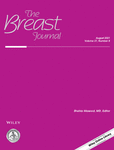Breast cancer in young women: Imaging and clinical course
Abstract
The purpose of this study was to characterize presenting imaging findings in women younger than 40 diagnosed with invasive breast cancer in the context of pathology and clinical course. Retrospective chart and imaging reviews were performed in patients under 40 diagnosed with breast cancer between July 1, 2004, and December 31, 2013. Patient demographic, imaging, pathology, and clinical data were collected. Overall and recurrence-free survival were estimated using the Kaplan-Meier method. Univariate Cox proportional hazards models were performed to identify factors associated with recurrence-free survival. Our study cohort consisted of 110 patients with invasive mammary carcinoma. One hundred one (91.8%) presented with a palpable mass. The mean size of all lesions on imaging was 3.5 cm ± 2.9 cm. Malignant calcifications were present in 54 (49.1%) cases. Imaging demonstrated multifocal or multicentric disease in 45 (40.9%) cases. Seventy four (67.3%) cancers were high grade. Luminal genomic subtypes were the most common (n = 61, 55.5%). At presentation, 4 (3.6%) patients had bilateral malignancy and 8 (7.3%) patients had distant metastatic disease. Ninety seven (88.2%) underwent neoadjuvant chemotherapy and 67 (60.9%) underwent radiation therapy. Seventy five (68.2%) of the patients underwent mastectomy. The restricted mean time to recurrence was 9.01 years (standard error 3.162 months). ER positivity was associated with compromised recurrence-free survival. The overall survival rate was 0.962 at 10 years. Young patients diagnosed with breast cancer typically present with advanced breast imaging findings and undergo aggressive treatment. Recurrence often occurs >5 years from diagnosis, and ER positive subtypes are at increased risk for recurrence.
CONFLICT OF INTEREST
The authors declare that there is no conflict of interest.




